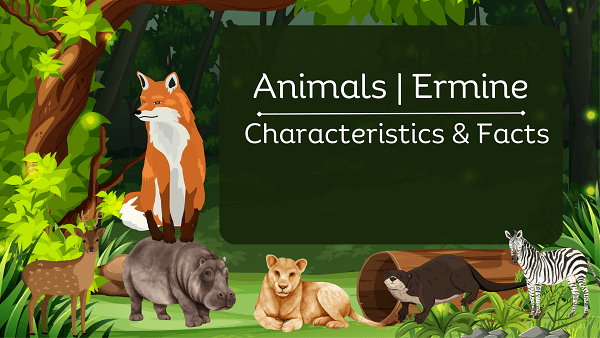Ermine (also known as stoat) Definition | Characteristics & Facts
Home » Animals » Ermine (also known as stoat) Definition | Characteristics & Facts
Ermine Definition
Ermine, also known as the stoat (scientific name: Mustela erminea), is a small carnivorous mammal belonging to the family Mustelidae. It is native to northern regions of North America, Europe, and Asia. T
Ermine General Characteristics & Facts
Size
Stoats are small to medium-sized mammals, measuring about 7 to 13 inches (18 to 33 cm) in body length, with an additional 2 to 5 inches (5 to 13 cm) for their tail.
Weight
They typically weigh around 6 to 12 ounces (170 to 340 grams), with males being slightly larger than females.
Coat Color
In their summer coat, stoats have a brown back, creamy white underparts, and a distinct line separating the two colors. In winter, their fur turns almost entirely white, except for the black-tipped tail.
Range
Stoats are found in the northern regions of North America, Europe, and Asia. They inhabit a wide range of habitats, from grasslands and forests to tundra and mountainous regions.
Adaptability
Stoats are highly adaptable animals and can thrive in various environments, including both natural and human-altered landscapes.
Predatory Behavior
They are skilled hunters with excellent speed, agility, and endurance. Stoats are known for their “dance of death” hunting technique, where they mesmerize their prey, such as rabbits or rodents, with quick and unpredictable movements before delivering a swift, fatal bite.
Reproduction
Stoats breed in the spring and give birth to litters of about 6 to 12 kits after a gestation period of about 10 months. The kits are born blind and helpless and remain in the den for several weeks before becoming independent.
Communication
Stoats use a range of vocalizations, including hisses, chirps, and squeals, for communication. They also leave scent markings to establish territory and communicate with other stoats.
Seasonal Color Change
The stoat’s ability to change its coat color is called “seasonal dimorphism.” This adaptation allows them to blend into their surroundings and improve their chances of survival during different seasons.
Energetic Behavior
Stoats are highly energetic animals, and they are known for their playful behavior, particularly when they are young.
Impact on Ecosystem
As efficient predators of small rodents, stoats play a crucial role in controlling rodent populations, which can have significant effects on ecosystems and agricultural lands.
Conservation Status
In many regions, stoats are considered a species of least concern in terms of conservation status. However, localized declines may occur due to habitat loss or changes in prey availability.
Read our Animals Encyclopedia with Complete Facts
Physical Characteristics Ermine
- Size: The stoat is a small to medium-sized carnivorous mammal. Its body length typically ranges from about 7 to 13 inches (18 to 33 cm).
- Tail: The stoat has a relatively long and bushy tail, measuring about 2 to 5 inches (5 to 13 cm) in length. The tail is distinctive and helps with balance, especially during rapid movements.
- Body Shape: It has a slender, elongated body with a streamlined shape, which enables it to move swiftly and efficiently through its habitat.
- Legs: The stoat has short legs, which contribute to its agile and nimble movements.
- Weight: Adults generally weigh around 6 to 12 ounces (170 to 340 grams), with males being slightly larger and heavier than females.
- Coat Color: The stoat’s fur undergoes seasonal color change. In the summer, the upper parts of its body are brown, while the underparts are creamy white. A clear line separates the two colors. In the winter, the fur turns almost entirely white, providing excellent camouflage in snow-covered environments.
- Winter Adaptation: During the winter, the stoat’s coat transformation to all-white (except for the black-tipped tail) is an example of “seasonal dimorphism,”
Continue To Explore All Animals That Start With E
Scientific Classification of Ermine
Kingdom: Animalia
Phylum: Chordata
Class: Mammalia
Order: Carnivora
Family: Mustelidae
Genus: Mustela
Species: Mustela erminea
Key Locations of Ermine
- North America
- Europe
- Asia
- Tundra
- Forests
- Grasslands
- Mountainous Regions
- Human-Altered Landscapes
View All A-Z Animals List
FAQs Ermine
What does Ermine eat?
- Small Rodents
- Rabbits
- Birds
- Insects
- Other Small Prey



